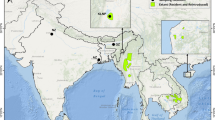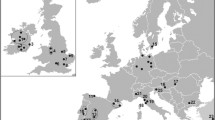Abstract
Translocations are an effectual management strategy for the reestablishment and reconnection of endangered populations and species. However, knowledge about the evolution and ecology of the populations and species of interest are critical so that informed decisions can be made about source populations and reestablishment areas. We employed 614 base pairs of the mitochondrial control region and 15 microsatellite loci to investigate genetic variation, contemporary connectivity, and interspecific hybridization in the two remaining populations of the endangered Columbian white-tailed deer (Odocoileus virginianus leucurus) through comparisons with the closest subspecies, O. v. ochrourus. Our data revealed the dubious taxonomic status of O. v. leucurus, and that O. virginianus in the Pacific Northwest originated from a single historic gene pool. Further the results identified that populations are currently genetically isolated and depauperate, and uncovered historic introgression with O. hemionus columbianus. These results suggest that translocations are a viable approach for reestablishing populations throughout the historic range to increase genetic diversity in the fragmented populations. Despite the taxonomic ambiguity, our study revealed the presence of unique genetic variation within each population which supports ongoing conservation efforts.




Similar content being viewed by others
References
Allee WC, Park O, Emerson AE, Park T, Schmidt KP (1949) Principles of animal ecology. WB Saunders Co. Ltd, Philadelphia
Anderson JD, Honeycutt RL, Gonzales RA, Gee KL, Skow LC, Gallagher RL, Honeycutt DA, DeYoung RW (2002) Development of microsatellite DNA markers for the automated genetic characterization of white-tailed deer populations. J Wildl Manage 66:67–74
Avise J, Ball R (1990) Principles of genealogical concordance in species concepts and biological taxonomy. In: Futuyma D, Antonovics J (eds) Oxford surveys in evolutionary biology. Oxford University Press, New York, pp 45–67
Bailey V (1936) The mammals and life zones of Oregon. North Am Fauna 55:1–348
Ballinger S, Blankenship L, Bickham J, Carr S (1992) Allozyme and mitochondrial DNA analysis of a hybrid zone between white-tailed deer and mule deer (Odocoileus) in west texas. Biochem Genet 30:1–11
Bandelt HJ, Forster P, Röhl A (1999) Median-joining networks for inferring intraspecific phylogenies. Mol Biol Evol 16:37–48
Bouzat J, Johnson J, Toepfer J, Simpson S, Esker T, Westemeier R (2009) Beyond the beneficial effects of translocations as an effective tool for the genetic restoration of isolated populations. Conserv Genet 10:191–201
Brookshier J (2004) Managment recommendations for washington’s priority species: volume V mammals. Washington Department of Fish and Wildlife, Olympia, pp 1–9 (ed. Wildlife WDoFa)
Carr SM, Ballinger SW, Derr JN, Blankenship LH, Bickham JW (1986) Mitochondrial DNA analysis of hybridization between sympatric white-tailed deer and mule deer in west Texas. Proc Natl Acad Sci 83:9576–9580
Cathey JC, Bickham JW, Patton JC (1998) Introgressive hybridization and nonconcordant evolutionary history of maternal and paternal lineages in North American deer. Evolution 52:1224–1229
Cowan IM (1936) Distribution and variation in deer (genus Odocoileus) of the Pacific Coastal Region of North America. California Fish and Game 22:155–246
Crandall KA, Bininda-Emonds ORP, Mace GM, Wayne RK (2000) Considering evolutionary processes in conservation biology. Trends Ecol Evol 15:290–295
Crawford NG (2010) SMOGD: software for the measurement of genetic diversity. Molecular Ecology Resources 10:556–557
Cronin MA (1991) Mitochondrial and nuclear genetic relationships of deer (Odocoileus spp.) in western North America. Can J Zool 69:1270–1279
Cronin MA (1992) Intraspecific variation in mitochondrial DNA of North American cervids. J Mammal 73:70–82
Cronin MA (2006) A proposal to eliminate redundant terminology for intra-species groups. Wildl Soc Bull 34:237–241
Cronin MA, Vyse ER, Cameron DG (1988) Genetic relationships between mule deer and white-tailed deer in Montana. J Wildl Manage 52:320–328
Cullingham CI, Merrill EH, Pybus MJ, Bollinger TK, Wilson GA, Coltman DW (2011) Broad and fine-scale genetic analysis of white-tailed deer populations: estimating the relative risk of chronic wasting disease spread. Evol Appl 4:116–131
Derr JN, Hale DW, Ellsworth DL, Bickham JW (1991) Fertility in an F1 male hybrid of white-tailed deer (Odocoileus virginianus) × mule deer (O. hemionus). J Reprod Fertil 93:111–117
Deyoung RW, Demarais S, Honeycutt RL, Rooney AP, Gonzales RA, Gee KL (2003) Genetic consequences of white-tailed deer (Odocoileus virginianus) restoration in Mississippi. Mol Ecol 12:3237–3252
Douglas D (1829) Observations of two undescribed species of North American Mammalia. Zool J 4:330–332
Dubois A (2003) The relationships between taxonomy and conservation biology in the century of extinctions. Comptes Rendus Biologies 326(supplement 1):9–21
Edmands S (2007) Between a rock and a hard place: evaluating the relative risks of inbreeding and outbreeding for conservation and management. Mol Ecol 16:463–475
Excoffier L, Lischer HEL (2010) Arlequin suite ver 3.5: a new series of programs to perform population genetics analyses under Linux and Windows. Mol Ecol Resour 10:564–567
Felsenstein J (1985) Confidence limits on phylogenies: an approach using the bootstrap. Evolution 39:783–791
Frankham R, Ballou JD, Eldridge MD, Lacy RC, Ralls K, Dudash MR, Fenster CB (2011) Predicting the probability of outbreeding depression. Conserv Biol 25:465–475
Galindo-Leal C, Weber M (1994) Translocation of deer subspecies: reproductive implications. Wildl Soc Bull 22:117–120
Gavin TA (1978) Status of the Columbian white-tailed deer Odocoileus virginianus leucurus: some quantitative uses of biogeographic data. In: Holloway CW (ed) Threatened deer. IUCN, Morges, Switzerland, pp 185–202
Gavin TA (1984) Pacific Northwest. In: Halls LK (ed) White-tailed deer ecology and management. Stackpole Books, Harrisburg, PA, pp 487–496
Gavin TA, May B (1988) Taxonomic status and genetic purity of Columbian white-tailed deer. J Wildl Manage 52:1–10
Glez-Peña D, Gómez-Blanco D, Reboiro-Jato M, Fdez-Riverola F, Posada D (2010) ALTER: program-oriented conversion of DNA and protein alignments. Nucleic Acids Res 38:W14–W18
Haig SM, Beever EA, Chambers SM, Draheim HM, Dugger BD, Dunham S, Elliott-Smith E, Fontaine JB, Kesler DC, Knaus BJ, Lopes IF, Loschl P, Mullins TD, Sheffield LM (2006) Taxonomic considerations in listing subspecies under the U.S. endangered species act. Conserv Biol 20:1584–1594
Hedrick P, Fredrickson R (2010) Genetic rescue guidelines with examples from Mexican wolves and Florida panthers. Conserv Genet 11:615–626
Hedrick PW, Kim TJ, Parker KM (2001) Parasite resistance and genetic variation in the endangered Gila topminnow. Anim Conserv 4:103–109
IUCN (1987) IUCN position statement on translocation of living organisms: introductions, re-introductions and re-stocking. https://portals.iucn.org/library/node/6507. Accessed 1 Feb 2013
Jon MJ, Witham JH (1990) Post-translocation survival and movements of metropolitan white-tailed deer. Wildl Soc Bull 18:434–441
Jost L (2008) GST and its relatives do not measure differentiation. Mol Ecol 17:4015–4026
Kalinowski ST (2005) hp-rare 1.0: a computer program for performing rarefaction on measures of allelic richness. Mol Ecol Notes 5:187–189
Klingenberg CP, Gidaszewski NA (2010) Testing and quantifying phylogenetic signals and homoplasy in morphometric data. Syst Biol 59:245–261
Lesica P, Allendorf FW (1995) When are peripheral populations valuable for conservation? Conserv Biol 9:753–760
Librado P, Rozas J (2009) DNASP v5: a software for comprehensive analysis of DNA polymorphism data. Bioinformatics 25:1451–1452
Lingle S (1993) Escape gaits of white-tailed deer, mule deer, and their hybrids: body configuration, biomechanics, and function. Can J Zool 71:708–724
Livingston SD (1987) Prehistoric biogeography of white-tailed deer in Washington and Oregon. J Wildl Manage 51:649–654
Lodé T, Guiral G, Peltier D (2005) European mink–polecat hybridization events: hazards from natural process? J Hered 96:89–96
Lopez S, Rousset F, Shaw FH, Shaw RG, Ronce O (2009) Joint effects of inbreeding and local adaptation on the evolution of genetic load after fragmentation. Conserv Biol 23:1618–1627
Mayr E (1963) Animal species and evolution. Harvard University Press, Cambridge, MA
Moritz C (1994) Defining ‘evolutionarily significant units’ for conservation. Trends Ecol Evol 9:373–375
O’Brien SJ, Mayr E (1991) Bureaucratic mischief: recognizing endangered species and subspecies. Science (Washington) 251:1187–1188
Peakall R, Smouse PE (2006) GENALEX 6: genetic analysis in Excel. Population genetic software for teaching and research. Mol Ecol Notes 6:288–295
Peek JM (1984) Northern rocky mountains. In: Halls LK (ed) White-tailed deer ecology and management. Stackpole Books, Harrisburg, PA, pp 497–512
Pimentel RA, Riggins R (1987) The nature of cladistic data. Cladistics 3:201–209
Posada D (2008) jMODELTEST: phylogenetic model averaging. Mol Biol Evol 25:1253–1256
Posada D, Crandall KA (2001) Intraspecific gene genealogies: trees grafting into networks. Trends Ecol Evol 16:37–45
Pritchard JK, Stephens M, Donnelly P (2000) Inference of population structure using multilocus genotype data. Genetics 155:945–959
Pritchard J, Wen X, Falush D (2007) Documentation for structure software: version 2.2. Department of Human Genetics, University of Chicago, Department of Statistics, University of Oxford
Purdue JR, Smith MH, Patton JC (2000) Female philopatry and extreme spatial genetic heterogeneity in white-tailed deer. J Mammal 81:179–185
Putman R, Flueck WT (2011) Intraspecific variation in biology and ecology of deer: magnitude and causation. Animal Production Science 51:277–291
Rhymer JM, Simberloff D (1996) Extinction by hybridization and introgression. Ann Rev Ecol Systemat 27:83–109
Rice WR (1989) Analyzing tables of statistical tests. Evolution 43:223–225
Scheffer VB (1940) A newly located herd of Pacific white-tailed deer. J Mammal 21:271–282
Sgrò CM, Lowe AJ, Hoffmann AA (2011) Building evolutionary resilience for conserving biodiversity under climate change. Evol Appl 4:326–337
Shaffer ML (1981) Minimum population sizes for species conservation. Bioscience 31:131–134
Smith WP (1985) Current geographic distribution and abundance of Columbian white-tailed deer, Odocoileus virginianus leucurus (Douglas). Northwest Sci 59:243–251
Smith WP, Carraway LN, Gavin TA (2003) Cranial variation in Columbian white-tailed deer populations: implications for taxonomy and restoration. Proc Biol Soc Wash 116:1–15
Soltis PS, Gitzendanner MA (1999) Molecular systematics and the conservation of rare species. Conserv Biol 13:471–483
Spielman D, Brook B, Briscoe D, Frankham R (2004) Does inbreeding and loss of genetic diversity decrease disease resistance? Conserv Genet 5:439–448
Storfer A (1999) Gene flow and endangered species translocations: a topic revisited. Biol Conserv 87:173–180
Suring LH, Vohs PA Jr (1979) Habitat use by Columbian white-tailed deer. J Wildl Manage 43:610–619
Swofford DL (2003) PAUP*: phylogenetic analysis using parsimony, version 4.0 b10
van Oosterhout C, Hutchinson WF, Wills DPM, Shipley P (2004) Micro-Checker: software for identifying and correcting genotyping errors in microsatellite data. Mol Ecol Notes 4:535–538
Vergeer P, Sonderen E, Ouborg NJ (2004) Introduction strategies put to the test: local adaptation versus heterosis. Conserv Biol 18:812–821
Waples RS, Gaggiotti O (2006) What is a population? An empirical evaluation of some genetic methods for identifying the number of gene pools and their degree of connectivity. Mol Ecol 15:1419–1439
Weeks AR, Sgro CM, Young AG, Frankham R, Mitchell NJ, Miller KA, Byrne M, Coates DJ, Eldridge MDB, Sunnucks P, Breed MF, James EA, Hoffmann AA (2011) Assessing the benefits and risks of translocations in changing environments: a genetic perspective. Evol Appl 4:709–725
Weir BS, Cockerham CC (1984) Estimating F-statistics for the analysis of population structure. Evolution 38:1358–1370
Wilson EO, Brown WL Jr (1953) The subspecies concept and its taxonomic application. Syst Zool 2:97–111
Zink RM (2004) The role of subspecies in obscuring avian biological diversity and misleading conservation policy. Proc R Soc Lond B Biol Sci 271:561–564
Acknowledgments
We would like to thank Shannon Wills and the Cowlitz Indian Tribe for samples, support, and consultation. At the Oregon Department of Fish and Wildlife we thank Hansel Hayden, Nick Leonetti, Martha Albritten, Leonard Erickson, and Richard Green for samples and funding. We also thank Kurt VerCauteren, Scott Hygnstrom of the United States Department of Agriculture National Wildlife Research Center, and Kenneth Warheit of the Washington Department of Fish and Wildlife for samples. Brett Coghlan, Julia Figueroa, Doreen Griffin, and Melissa Neubaum all contributed to the lab work. We would also like to exress our gratitude to two anonymous reviewers as they greatly improved this manuscript.
Author information
Authors and Affiliations
Corresponding author
Electronic supplementary material
Below is the link to the electronic supplementary material.
Rights and permissions
About this article
Cite this article
Hopken, M.W., Lum, T.M., Meyers, P.M. et al. Molecular assessment of translocation and management of an endangered subspecies of white-tailed deer (Odocoileus virginianus). Conserv Genet 16, 635–647 (2015). https://doi.org/10.1007/s10592-014-0689-6
Received:
Accepted:
Published:
Issue Date:
DOI: https://doi.org/10.1007/s10592-014-0689-6




